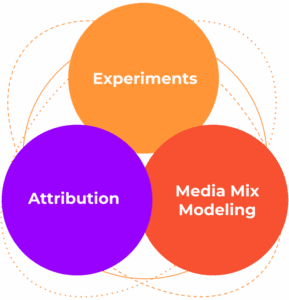CMOs are facing a persistent truth. They can’t fully trust the story that their measurement and reports are telling, meaning they’re all but navigating blind in an increasingly competitive landscape.
Why can’t CMOs trust their reporting?
There isn’t a single silver bullet to nailing measurement. While each approach offers distinct advantages, when used in isolation the strengths of these approaches are being outweighed by varying limitations across scope, accuracy or accessibility.
Attribution tools, such as Google Analytics or ad platform reports, provide the fastest and most readily available insights — offering strength in speed. However, their effectiveness is limited without incremental measurement, and they are increasingly impacted by signal loss and privacy constraints.
Media mix modeling delivers the broadest cross-channel perspective and remains resilient to signal degradation, giving it strength in scope. Yet, it lacks the granularity and precision of more experimental approaches.
Experimentation methods — such as conversion-based tests and GeoLift studies — offer high levels of accuracy and can measure causal, incremental impact, making them highly actionable. Their key limitation, however, lies in their narrower application range.
To build trust in marketing performance and unlock actionable insights, CMOs must integrate these methods into a cohesive measurement framework.
Closing the gaps in your measurement approach
Without confidence in their measurement strategy, CMOs face significant consequences. The lack of reliable insight weakens strategic decision making, leaving marketing leaders less empowered to lead.
The solution to rebuilding trust in reporting and regaining strategic clarity is in the triangulation of multiple methodologies – a Unified Marketing Measurement (UMM) solution.

The gold standard for accurate and actionable marketing intelligence, each measurement approach plays a critical role in the UMM framework.
- Media Mix Modelling (MMM): Used to allocate optimal budgets and forecast outcomes
- Incrementality Testing: Used to measure incrementality and calibrate models like MMM & MTA
- Attribution: Used to make real-time, granular campaign optimizations
Incrementality experiments serve as a foundational tool to calibrate both media mix models (MMM) and multi-touch attribution (MTA), ensuring they are grounded in reality. When discrepancies arise between MMM and attribution results, model-attribution mismatch helps inform a focused testing strategy — guiding where lift studies should be prioritized next. Additionally, triangulated iROAS (incremental Return on Ad Spend) provides a more reliable benchmark to inform budget reallocations at the platform level.
By leveraging these methodologies together, CMOs can overcome the limitations of any single approach and build a robust, trustworthy measurement strategy that connects performance with impact.
How attribution, MMM and incrementality testing work together
Integrating attribution, media mix modeling (MMM), and incrementality testing is essential to achieving unified marketing measurement.
Attribution provides the real-time granularity needed for tactical decisions on channel and campaign optimization. It fills the gaps left by MMM by helping measure channels without the necessary data volumes to be measured by econometric modelling methods as well as providing a more real time view. MMM, in turn, supports strategic planning and budget allocation across channels, helping advertisers move towards a world of measuring the incremental value of marketing channels – not just where they were present in a customer journey. It’s a vital tool to help course correct for some of the industries over reliance on marketing activities that focus on being more ‘easy to find’ rather than ‘quick to mind’. Incrementality testing validates the accuracy of both attribution and MMM by measuring the true causal impact of marketing investments. It helps calibrate models, uncover blind spots in attribution, and assess the effectiveness of new channels faster than MMM alone. Extensive experimentation results are also incredibly beneficial in their ability to reduce time to value with MMM models, by helping provide that prior information – econometric models can work with channels with data volumes lower than what it would be able to do otherwise.
When integrated, these tools create a more complete, reliable, and actionable measurement ecosystem.
Going beyond media measurement within MMM
The accuracy and relatability of MMM hinges on how comprehensively it accounts for the real-world drivers of performance; which means a media-only model may only tell half the story. Marketers need to look beyond just media measurement when using MMM – changing the narrative from a media performance tool to a comprehensive marketing effectiveness platform.
Marketers can unlock significant incremental growth by leveraging additional data within their MMM approach, such as:
- Owned media (website UX, SEO content)
- Earned media (PR, word-of-mouth, influencer mentions)
- Promotions (discounting, bundling strategies)
- Product and pricing change
- Macroeconomic conditions (inflation, unemployment)
- Seasonality and holidays
- Creative
These components can significantly impact sales, and not considering them within your model can lead to inaccuracies and sub-optimal decision making. Armed with information of how elements such as pricing or creative quality/messaging affects your bottom line performance – relevant to media investments – you’ll be able to answer some of the longest standing questions facing CMO’s such as: If I have $250k budget – how much of that should I invest in media (and where) versus creative versus discounting?
An example of why looking beyond media is important is demonstrated in a recent campaign where we partnered with a client to undertake a MMM project aimed at uncovering the incremental impact of marketing activities across the entire funnel, focusing on promotions. By running a deep MMM analysis, incorporating a multitude of additional factors outside of media, we were able to reveal that two of the brand’s promotional campaigns were highly incremental, driving both scale and profitability. However, a third-tier promotion was generating negative returns. Armed with this data, the brand quickly adjusted their promotional calendar, reallocating spend to high-performing campaigns and eliminating inefficiencies — significantly improving marketing ROI and driving sustainable growth.
Reframing measurement as a competitive advantage
CMOs who outperform don’t just track results — they shape them. By transforming how reporting is structured, interpreted, and acted upon, CMOs can not only regain confidence in their data but use it as a springboard for smarter, faster, more aligned decision-making.
At Incubeta, we call this Outperform Marketing — a strategic approach where connected data, seamless integration, and outcome-driven insights come together to unlock profitable growth.
If you’re ready to reshape your business measurement model and outperform, get in touch with our specialists today. Regain your marketing confidence with UMM:



